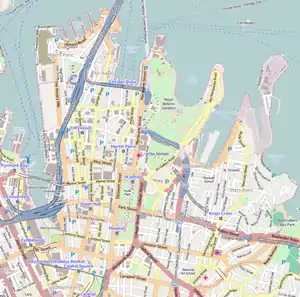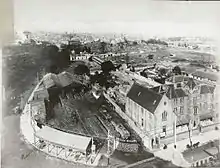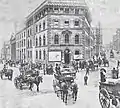Pitt Street
Pitt Street is a major street in the Sydney central business district in New South Wales, Australia. The street runs through the entire city centre from Circular Quay in the north to Waterloo, although today's street is in two disjointed sections after a substantial stretch of it was removed to make way for Sydney's Central railway station. Pitt Street is well known for the pedestrian only retail centre of Pitt Street Mall, a section of the street which runs from King Street to Market Street.
Pitt Street | |
|---|---|
 | |
| Pitt Street, looking north | |
 Northern end Southern end | |
| Coordinates |
|
| General information | |
| Type | Street |
| Length | 2.5 km (1.6 mi) |
| Major junctions | |
| Northern end | Alfred Street Sydney CBD |
| Southern end | George Street Haymarket, Sydney |
| Location(s) | |
| LGA(s) | City of Sydney |
| Major suburbs | Sydney CBD, Haymarket |
Pitt Street is a one way (southbound only) from Circular Quay to Pitt Street Mall and (northbound only) from Pitt Street Mall to Goulburn Street, while Pitt Street Mall is for pedestrians only. It is dominated by retail and commercial office space.
History
Pitt Street was originally named Pitt Row,[1] and is one of the earliest named streets in Sydney. Pitt Street is believed to have been named by Governor Arthur Phillip in honour of William Pitt the Younger, at the time, the Prime Minister of Great Britain.[2] In 1853, Pitt Street was extended north from Hunter Street to Circular Quay.[3]

Pitt Street was previously a one-way street in a southerly direction from Circular Quay to Campbell Street. In preparation for the construction of the Pitt Street Mall, in February 1987 the sections between Hunter Street and Martin Place, and Martin Place and King Street were converted to two-way cul de sacs to allow the Martin Place plaza to be extended. This was later reverted and today the Circular Quay to King Street section is one-way throughout in a southerly direction. From Goulburn Street to Park Street was converted to become one-way in a northerly direction. The Market Street to Park Street section initially remained as a southbound street, but was later converted to run northbound. The Goulburn Street to Campbell Street section was converted to two-way.[4][5][6]
Tram line
The Circular Quay to Central station line was an important part of the Sydney tram network. It was an extremely busy service for passengers transferring from suburban trains, particularly prior to the opening of the City Circle underground railway line in 1926. Trams operated in a loop from Central station, running north along Pitt Street to Circular Quay returning south via Castlereagh Street. These tracks were also used by some eastern and south-western routes during busy periods. The line closed on 27 September 1957 with four tram services replaced with buses and three others diverted to operate via Elizabeth Street.[7][8] The line made use of the sandstone viaduct onto the colonnade above Eddy Avenue at Central station, which since 1997 has formed part of the Inner West Light Rail.
Heritage-listed properties
The following properties, located on or adjacent to Pitt Street, are listed on various national, state, and/or local government heritage registers:
- Bulletin Place warehouses, on Bulletin Place, between Pitt Street and Macquarie Place[9][10][11]
- Commonwealth Trading Bank Building[12][13]
- Kings Hotel[14]
- Pitt Street Uniting Church[15]
- Soul Pattinson Building[16]
- The Strand Arcade[17]
- Sydney School of Arts building[18]
- Former Sydney Water Head Office[19]
- The Sydney Club[20]
- Wales House,[21] now part of the Radisson Blu hotel chain[22]
Pitt Street Cycleway
During the COVID-19 epidemic in 2020 the City of Sydney installed a "pop up" (or temporary) cycleway on Pitt Street. This cycleway was the busiest of all the pop up cycleways installed, with an average of 4430 weekly trips. [23]
In March 2021 the city announced the cycleway would become permanent. [24] It now connects to the King Street cycleway at the south end.
Gallery
 Sydney's first Tramways depot, corner of Pitt Street and what was then Gipps St West and Garden Road, looking SE across the Old Cemeteries towards Surry Hills. Eddy Avenue roughly follows Garden Road,[25] c. 1880.
Sydney's first Tramways depot, corner of Pitt Street and what was then Gipps St West and Garden Road, looking SE across the Old Cemeteries towards Surry Hills. Eddy Avenue roughly follows Garden Road,[25] c. 1880._City_Tattersals_Club.JPG.webp)

_Pitt_Street_(a).JPG.webp) Building in Italianate style
Building in Italianate style_Pitt_Street_(d).JPG.webp) Restored 1903 building
Restored 1903 building Pitt Street Mall from King Street looking south
Pitt Street Mall from King Street looking south Looking south c. 1900
Looking south c. 1900 Archival image of Pitt and Hunter Streets, showing Wales House
Archival image of Pitt and Hunter Streets, showing Wales HousePitt_St_Uniting_Church-5.jpg.webp) Pitt Street Uniting Church interior
Pitt Street Uniting Church interior.jpg.webp) Building labourer on a stone being hoisted up to building, Pitt St, Sydney, c1930s. Photo by Sam Hood.
Building labourer on a stone being hoisted up to building, Pitt St, Sydney, c1930s. Photo by Sam Hood.Pitt_St_Uniting_Church-4.jpg.webp) Pitt Street Uniting Church
Pitt Street Uniting Church
References
- "NOTES AND ANECDOTES ABOUT OLD PITT STREET: FROM ONE OfIr.C. H. BERTIE'S ARRESTING ARTICLES". National Library of Australia. The Freeman's Journal. 1 July 1920. Retrieved 6 December 2015.
- Reed, A. W. (1973). Place Names of Australia (1984 reprinted ed.). Frenchs Forest, NSW: Reed Books. p. 176. ISBN 0-589-50128-3.
- City of Sydney, Street Names 22 May 2009
- Changes to City Plan Effective February 8, 1987 Daily Telegraph 27 January 1987 page 15
- Work starts on new park street The Sun-Herald 8 February 1987 page 23
- Pitt Street mall Transit Australia May 1987 page 90
- New Details of Sunday's CHange-over to Buses in Sydney Sydney Morning Herald 27 September 1957 page 4
- Buses Replace Trams in Two Sydney Streets Truck & Bus Transportation November 1957 page 46
- "Bulletin Place Restaurant". New South Wales State Heritage Register. Department of Planning & Environment. H00651. Retrieved 13 October 2018.
 Text is licensed by State of New South Wales (Department of Planning and Environment) under CC-BY 4.0 licence.
Text is licensed by State of New South Wales (Department of Planning and Environment) under CC-BY 4.0 licence. - "Building". New South Wales State Heritage Register. Department of Planning & Environment. H00652. Retrieved 13 October 2018.
 Text is licensed by State of New South Wales (Department of Planning and Environment) under CC-BY 4.0 licence.
Text is licensed by State of New South Wales (Department of Planning and Environment) under CC-BY 4.0 licence. - "Warehouse (former)". New South Wales State Heritage Register. Department of Planning & Environment. H00653. Retrieved 13 October 2018.
 Text is licensed by State of New South Wales (Department of Planning and Environment) under CC-BY 4.0 licence.
Text is licensed by State of New South Wales (Department of Planning and Environment) under CC-BY 4.0 licence. - "Commonwealth Trading Bank Building, 108-120 Pitt St, Sydney, NSW, Australia (Place ID 1837)". Australian Heritage Database. Australian Government. Retrieved 20 April 2009.
- "Former "Commonwealth Bank of Australia Building" including interiors". New South Wales Heritage Database. Office of Environment & Heritage. Retrieved 21 May 2018.
- "Sugar House". New South Wales State Heritage Register. Department of Planning & Environment. H00417. Retrieved 13 October 2018.
 Text is licensed by State of New South Wales (Department of Planning and Environment) under CC-BY 4.0 licence.
Text is licensed by State of New South Wales (Department of Planning and Environment) under CC-BY 4.0 licence. - "Pitt Street Uniting Church". New South Wales State Heritage Register. Department of Planning & Environment. H00022. Retrieved 13 October 2018.
 Text is licensed by State of New South Wales (Department of Planning and Environment) under CC-BY 4.0 licence.
Text is licensed by State of New South Wales (Department of Planning and Environment) under CC-BY 4.0 licence. - "Former "Phoenix Chambers" and Soul Pattinson Store Including Interior". New South Wales Heritage Database. Office of Environment & Heritage. Retrieved 20 December 2018.
- "Strand Arcade". New South Wales State Heritage Register. Department of Planning & Environment. H01864. Retrieved 14 October 2018.
 Text is licensed by State of New South Wales (Department of Planning and Environment) under CC-BY 4.0 licence.
Text is licensed by State of New South Wales (Department of Planning and Environment) under CC-BY 4.0 licence. - "Sydney School of Arts". New South Wales State Heritage Register. Department of Planning & Environment. H00366. Retrieved 13 October 2018.
 Text is licensed by State of New South Wales (Department of Planning and Environment) under CC-BY 4.0 licence.
Text is licensed by State of New South Wales (Department of Planning and Environment) under CC-BY 4.0 licence. - "Sydney Water Head Office (former) (1939 building)". New South Wales State Heritage Register. Department of Planning & Environment. H01645. Retrieved 14 October 2018.
 Text is licensed by State of New South Wales (Department of Planning and Environment) under CC-BY 4.0 licence.
Text is licensed by State of New South Wales (Department of Planning and Environment) under CC-BY 4.0 licence. - "Sydney Club". New South Wales State Heritage Register. Department of Planning & Environment. H00583. Retrieved 13 October 2018.
 Text is licensed by State of New South Wales (Department of Planning and Environment) under CC-BY 4.0 licence.
Text is licensed by State of New South Wales (Department of Planning and Environment) under CC-BY 4.0 licence. - "Wales House". New South Wales State Heritage Register. Department of Planning & Environment. H00586. Retrieved 13 October 2018.
 Text is licensed by State of New South Wales (Department of Planning and Environment) under CC-BY 4.0 licence.
Text is licensed by State of New South Wales (Department of Planning and Environment) under CC-BY 4.0 licence. - "Gallery". Radisson Blu Sydney. Radisson Hotels. n.d. Retrieved 22 December 2018.
- Thompson, Nigel Gladstone, Angus (7 May 2021). "Sydney's most popular pop-up bike path overtakes city's busiest". The Sydney Morning Herald. Retrieved 9 February 2023.
{{cite web}}: CS1 maint: multiple names: authors list (link) - "Pitt Street leads the way with plans for a permanent cycleway | City of Sydney - News". news.cityofsydney.nsw.gov.au. Retrieved 9 February 2023.
- "Map of the city of Sydney, New South Wales". National Library of Australia. Retrieved 6 December 2015.
External links
- Catherine Bishop (2011). "Women of Pitt Street 1858". Dictionary of Sydney. Retrieved 30 September 2015. [CC-By-SA]
- Shirley Fitzgerald – City of Sydney History Unit (2008). "Poverty Point [corner of Park and Pitt Streets]". Dictionary of Sydney. Retrieved 28 September 2015. [CC-By-SA]